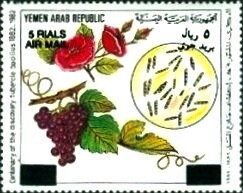Stamp: Bunch of grapes and flowers (Yemen 1993)
Bunch of grapes and flowers (Yemen 1993)
01 January (Yemen ) within release Stamps of Yemen Arab Republic surcharged goes into circulation Stamp Bunch of grapes and flowers face value 5 Yemeni riyal
| Stamp Bunch of grapes and flowers in catalogues | |
|---|---|
| Michel: | Mi: YE 95 |
| Stanley Gibbons: | Sg: YE 98 |
Stamp is square format.
Also in the issue Stamps of Yemen Arab Republic surcharged:
- Stamp - 26th Anniversary of the Revolution face value 8;
- Stamp - Arab Board for Medical Specialisations face value 10;
- Stamp - Arab Cooperation Council face value 10;
- Stamp - Palestinian 'Intifada' Movement face value 10;
- Stamp - Scout Conference face value 8;
- Stamp - Torch bearer face value 10;
- Stamp - 26th Anniversary of the Revolution face value 12;
- Stamp - Aircraft and Satellite face value 5;
- Stamp - Aircraft with Globe and Satellite face value 3;
- Stamp - Al-Hassan lbn Ahmed Al-Hamdani face value 3;
- Stamp - Arab Board for Medical Specialisations face value 12;
- Stamp - Arab Cooperation Council face value 12;
- Stamp - Bunch of grapes and flowers face value 5;
- Stamp - Deer face value 3;
- Stamp - Disabled face value 5;
- Stamp - First shipment oil face value 12;
- Stamp - General Population and Housing Census face value 8;
- Stamp - Horseman; Saladin, Sultan of Egypte face value 8;
- Stamp - Immunization Campaign face value 12;
- Stamp - Lemons and flowers face value 3;
- Stamp - Match scene and Pique face value 8;
- Stamp - Palestinian 'Intifada' Movement face value 12;
- Stamp - Running face value 5;
- Stamp - Soccer - Judo face value 12;
- Stamp - Telecommunications face value 3;
- Stamp - Telecommunications face value 5;
|
Data entry completed
50%
|
|
|---|---|
| Stamp Bunch of grapes and flowers in digits | |
| Country: | Yemen |
| Date: | 1993-01-01 |
| Print: | Offset lithography |
| Emission: | Air Post |
| Format: | Stamp |
| Face Value: | 5 Yemeni riyal |
Stamp Bunch of grapes and flowers it reflects the thematic directions:
A flower, sometimes known as a bloom or blossom, is the reproductive structure found in plants that are floral (plants of the division Magnoliophyta, also called angiosperms). The biological function of a flower is to effect reproduction, usually by providing a mechanism for the union of sperm with eggs. Flowers may facilitate outcrossing (fusion of sperm and eggs from different individuals in a population) or allow selfing (fusion of sperm and egg from the same flower). Some flowers produce diaspores without fertilization (parthenocarpy). Flowers contain sporangia and are the site where gametophytes develop. Many flowers have evolved to be attractive to animals, so as to cause them to be vectors for the transfer of pollen. After fertilization, the ovary of the flower develops into fruit containing seeds. In addition to facilitating the reproduction of flowering plants, flowers have long been admired and used by humans to beautify their environment, and also as objects of romance, ritual, religion, medicine and as a source of food.
In botany, a fruit is the seed-bearing structure in flowering plants (also known as angiosperms) formed from the ovary after flowering. Fruits are the means by which angiosperms disseminate seeds. Edible fruits, in particular, have propagated with the movements of humans and animals in a symbiotic relationship as a means for seed dispersal and nutrition; in fact, humans and many animals have become dependent on fruits as a source of food. Accordingly, fruits account for a substantial fraction of the world's agricultural output, and some (such as the apple and the pomegranate) have acquired extensive cultural and symbolic meanings. In common language usage, "fruit" normally means the fleshy seed-associated structures of a plant that are sweet or sour, and edible in the raw state, such as apples, bananas, grapes, lemons, oranges, and strawberries. On the other hand, in botanical usage, "fruit" includes many structures that are not commonly called "fruits", such as bean pods, corn kernels, tomatoes, and wheat grains. The section of a fungus that produces spores is also called a fruiting body.


